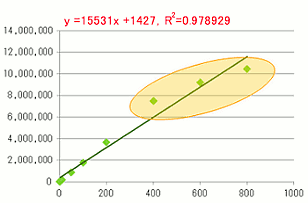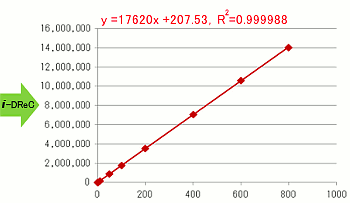The New i-DReC Analysis Method
What Is i-DReC? – An Introduction Through Application Examples –
When analyzing high-concentration samples, have you experienced cases where you were unable to obtain the peak area because the chromatogram exceeded the measurement limits of the detector (saturation)?
Here, we introduce the i-DReC (Intelligent Dynamic Range Extension Calculator), which extends the dynamic range and solves this problem.
The figures below show examples of indomethacin calibration curves that include high-concentration calibration points.

Calibration Curve for Indomethacin Samples Containing High-Concentration Calibration Points (Without i-DReC)

Calibration Curve for Indomethacin Samples Containing High-Concentration Calibration Points (With i-DReC)
| Measurement in High-Concentration Range (Concentration 400 mg/L min.) | Dilution of High-Concentration Sample | |
|
Existing Method
|
Linearity cannot be maintained and area value cannot be calculated correctly. | Required |
|
Using i-DReC
|
Maintains linearity and correctly calculates area value! | Not required! |
Advantage of i-DReC in Creating Calibration Curves
Quantitation Using Area Percentages
i-DReC is effective even in cases where you want to quantify trace impurities and the main components simultaneously. The figures below show examples of quantitative analyses of impurities by area percentages.

| Number of Analyses | Area Value and Concentration Correction by Dilution Procedure and Dilution Rate | |
|
Existing Method
|
2 runs (main components and impurities) | Required |
|
Using i-DReC
|
1 run to complete analysis! | Not required! |


